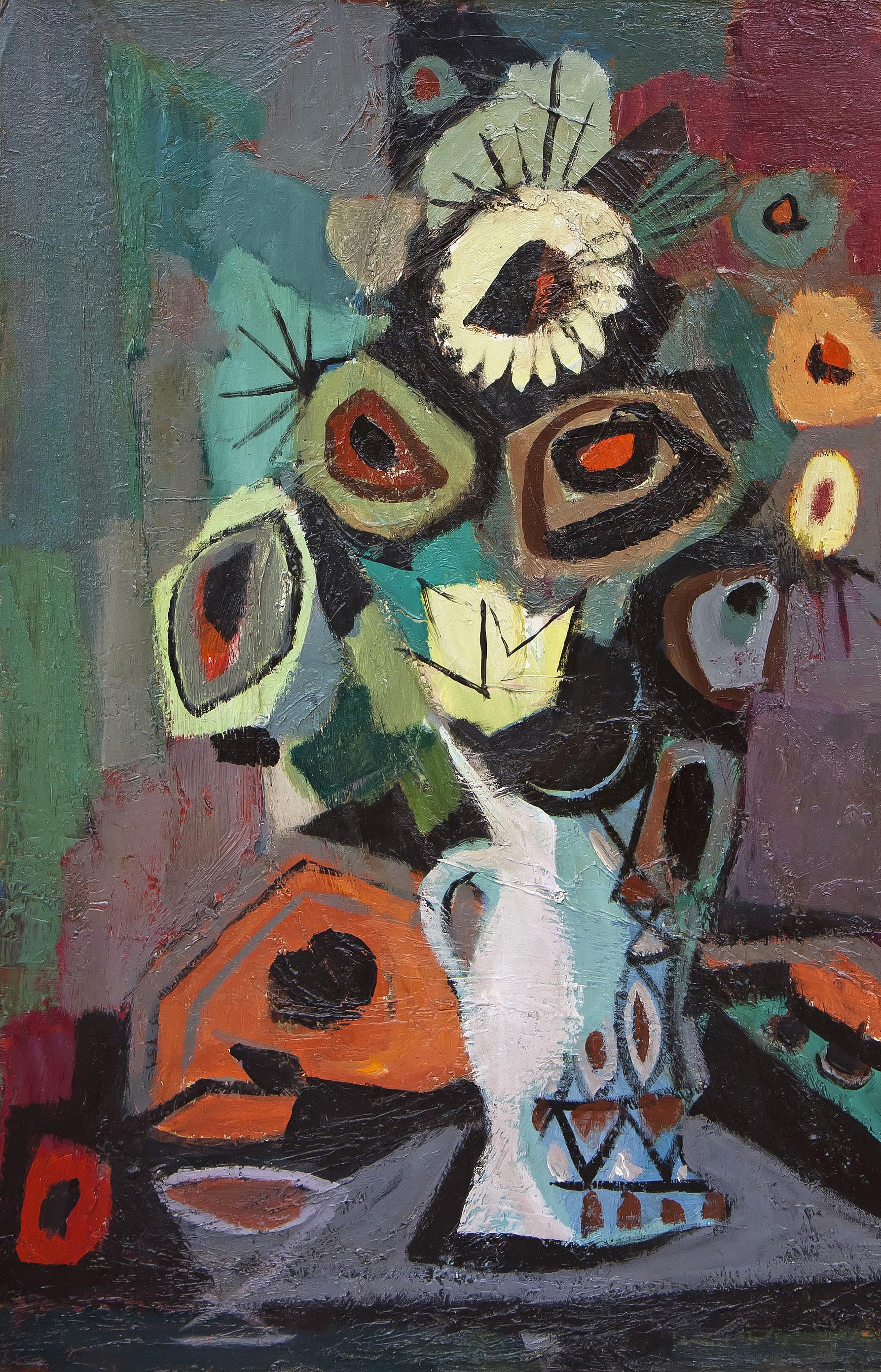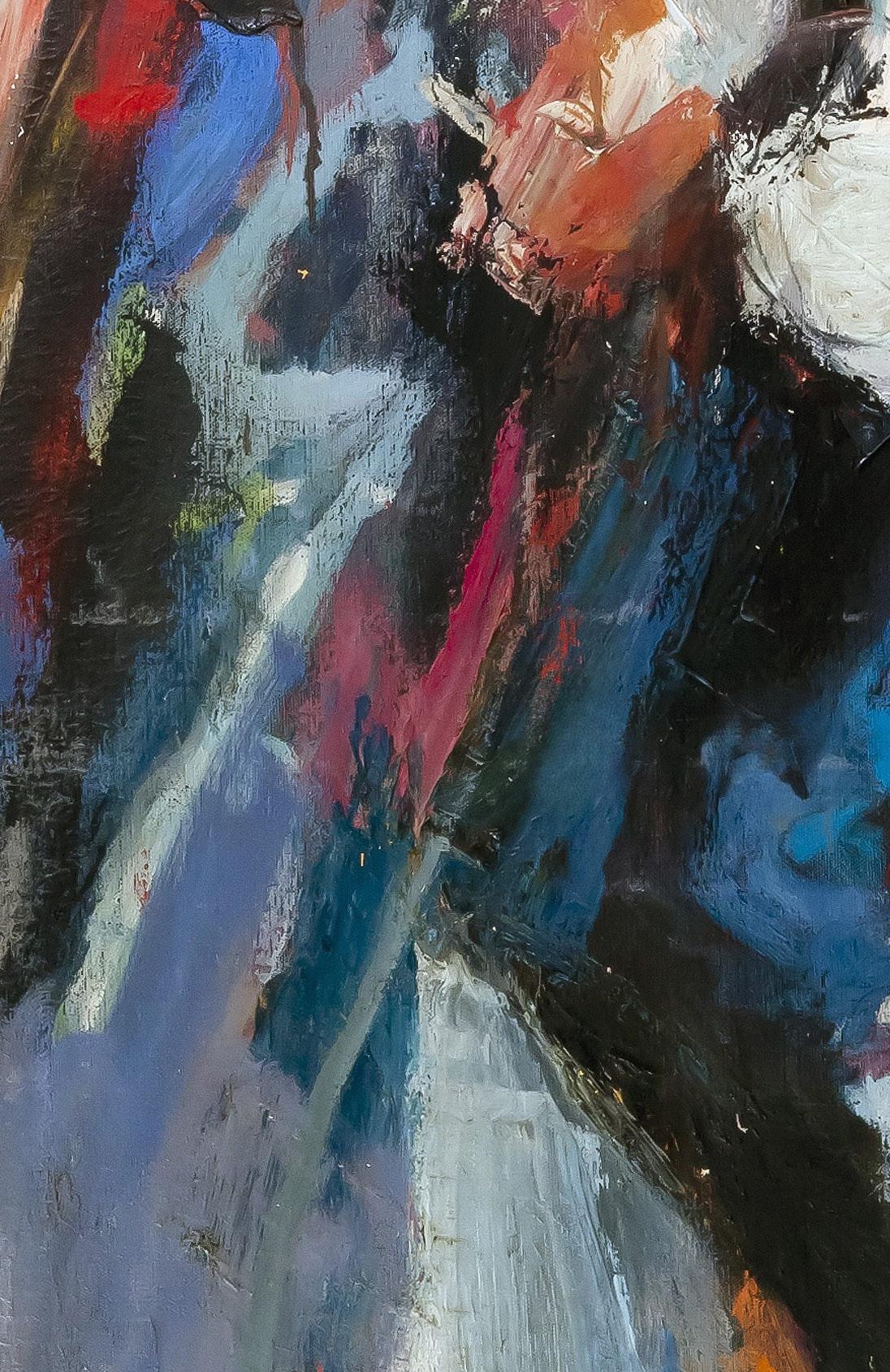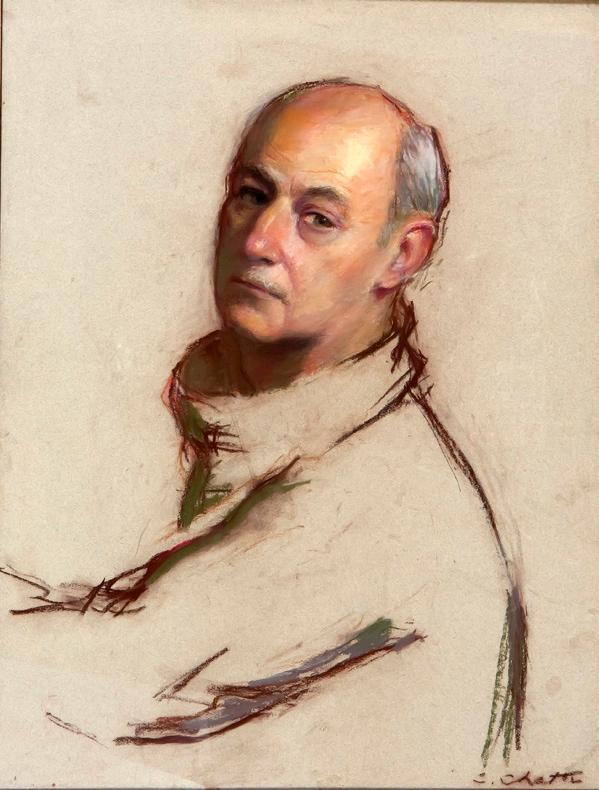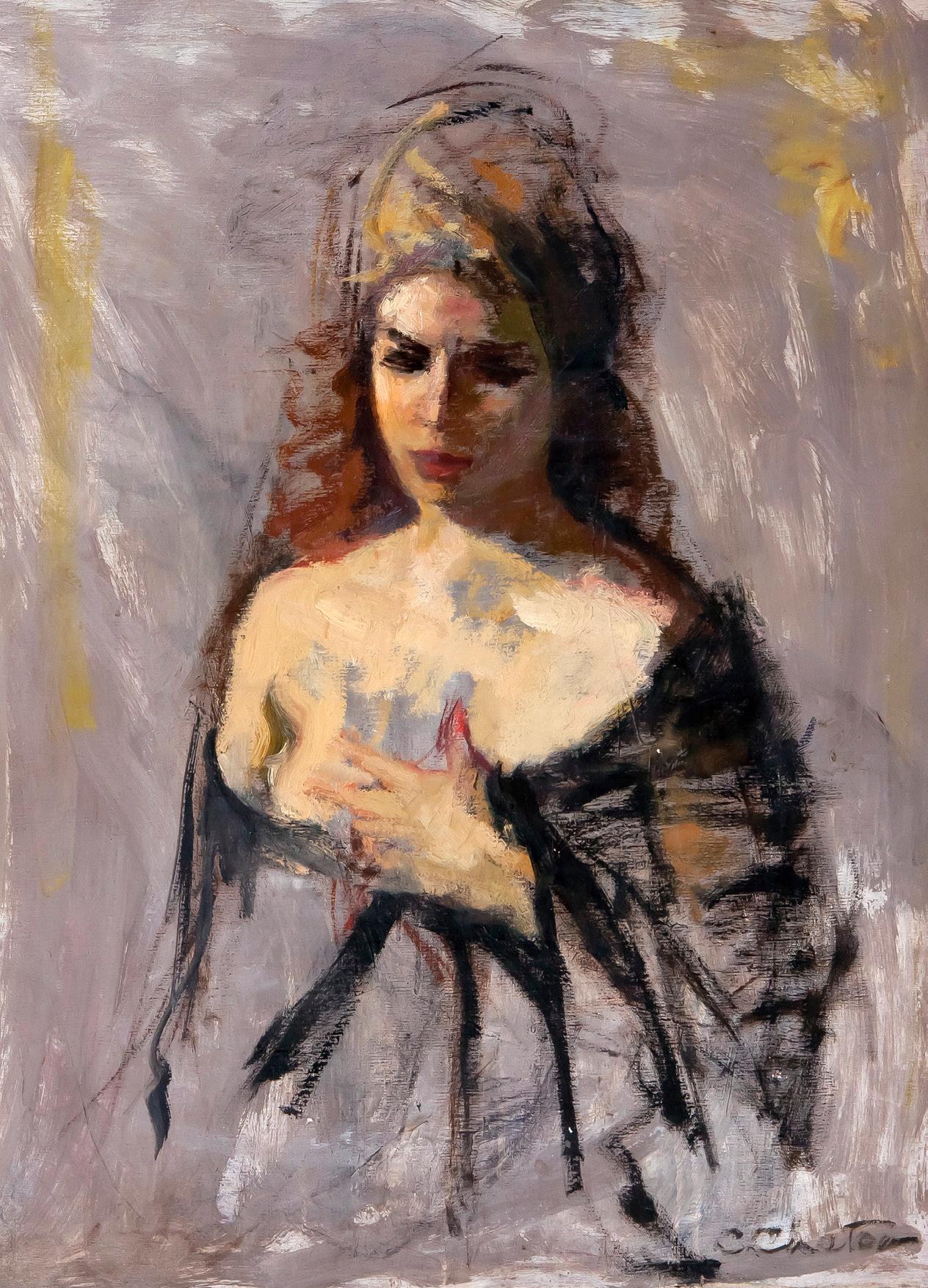CHATOV

A
Retrospective
of
Works by Roman, Constantin, and Marc Chatov

INSIDE COVER:


A
Retrospective
Works by Roman, Constantin, and Marc Chatov

INSIDE COVER:
An Exhibition at The Bascom: A Center for the Visual Arts
Highlands, North Carolina
August 23, 2025 - January 3, 2026
This exhibition celebrates the remarkable 125-year legacy of the Chatov family, whose profound contributions to fine art span multiple generations. Featuring a curated selection of paintings and sketches, this retrospective highlights the individual talents and shared artistic vision of Roman, Constantin, and Marc Chatov.
From Constantin's mastery of portraiture and Roman's innovative explorations of form to Marc's contemporary interpretations of traditional realism, the Chatov name is synonymous with artistic excellence, passion, and cultural influence. Together, their works illuminate a rich heritage of creativity and dedication, offering viewers an intimate journey through a family tradition that has shaped and enriched the landscape of fine art.
Words by Marc Chatov with special thanks to: Gaye Chatov, Operations Wizard of Chatov Studio
Roman Chatov was born in Rostov on Don, Southern Russia, in 1900. The son of a theater impresario, he began to draw at the age of fourteen. By age sixteen he was already illustrating for numerous magazines emerging as a military correspondent painter, making his drawings on the battlefields of World War I. After the Russian Revolution when Lenin gained power in 1922, Roman, his brother Constantin and his parents, fled their homeland for New York. "With the horrors of the civil war, our family decided to leave Russia because of communism," he said.
He received his early training as an artist in Russia and Paris. The young Roman's first published drawings were backstage sketches that appeared in Russian theater magazines. He continued his formal art education at the Art Students League and the National Academy of Arts and was a noted mural painter and costume designer
before turning his talents to portraiture.
President Roosevelt's Works Project Administration (WPA) commissioned Roman to paint murals for the Ford and Palestinian Pavilions at the 1939 New York World's Fair. This led to many commissions for murals throughout the country. Among his most notable commissioned works are his murals for New York's Russian Tea Room, which are currently in the Lincoln Center Library of Fine Art and Museum of the City of New York collections. Of his many murals, 'Cornucopia' may still be seen in the iconic art deco Edison Hotel in New York. Working in a Fifth Avenue studio, he designed costumes for the famous Broadway producer Florenz Ziegfeld of Ziegfeld Follies. When dancer Isadora Duncan admired some of his Spanish costumes, he made a large hand-painted shawl for her; the very one that strangled her when it got caught in the wheels of a car.

Roman was acquainted with Manhattan's most successful and dynamic artists and musicians including abstract expressionist Willem de Kooning, with whom he shared a studio in the 1930's.
In 1942 he married Geneva McCormack. Having established himself as a major artistic talent in New York, Roman Chatov became a renowned portrait painter when he and his brother Constantin were commissioned by MGM studios to paint portraits of top stars such as Vivien Leigh and Clark Gable during the Gone with the Wind era. He then began working
primarily on portraits which were carried by the Garibaldi Galleries in New York, however, in 1959 he ventured to Atlanta when commissioned to paint the mural for the Cabana Hotel opening. Two years later, he moved to Atlanta where he and his brother Constantin opened a studio together and taught art classes in addition to their commissions.
Roman Chatov's works have been shown in galleries and museums on both continents and are represented in many private and corporate collections. Roman was honored with the Governor's Award from the Georgia Council for the Arts and Humanities in 1983.
In 2014, the book Chatov was written by Morton Publishing. The book outlines the contributions of numerous members of the Chatov family, including Roman's undeniable influence on a generation of artists and his profound gifts to the world of art.

Jane Eagles , 1940
| Chatov
This portrait of Jane Eagles is an example of Roman's academic training and mastery of human anatomy and portraiture.

Exodus , 1958
Roman Chatov Oil and Pastel on Board, 43x36
The somber mood of this painting is an allegory of the Chatov family escape from Russia's Civil War in 1920.

Still Life with Book , 1950
Roman Chatov
O il on Canvas, 2 0x24
This is one of the paintings that Roman did during his time at Art Students League in NY with Brackman. This piece was very motivating to me when I was learning to paint. I have always admired it.

| Chatov Twisters , 1959
Chatov Oil on Panel, 24x20
Roman asked his son Marc to show him the new dance called the twist. Marc is the model in the white shirt posing for his Dad.

Marc , 1959
Roman Chatov
Charcoal and Chalk on Posterboard, 36x26
Dad had me pose for this and it was then that I decided I preferred the other side of the canvas.
Marcel M arceau , 196 0
When Roman visited France in the '50s he saw Marceau perform and fell in love with pantomime. Such performers are a repeated theme in many of his paintings.


Roman Chatov Oil on Panel, 30x24 Oil on Board, 16x12
Flowers with Mandolin , 1960
Roman Chatov
Typical of Roman's abstract period, this painting utilizes color and geometric form to create an emotional response. Take note of the mandolin.

Circus Tragedy , 196 5
Roman Chatov
Oil on Panel, 30x24
Roman painted this heartfelt allegory after the tragic loss of his eldest son. The horse and rider are known as Fate, depicted here symbolically trampling his son. The other figures are Roman reaching out along with his brother Constantin and youngest son; Marc.
The Thirst , 1964
Roman Chatov
Oil on Panel , 28x2 2
A favorite in the collection, this painting is reminiscent of the Russian icons that influenced Roman as a child.


Roman Chatov
Oil on Canvas, 24x20 Homer, 1965
This painting is a depiction of the blind poet, Homer, who wrote The Iliad and the Odyssey .
| Chatov

Pink Chair, 1965
Roman Chatov
Oil on Board, 50x30
The most important thing about this painting is not the nude, but rather the color relationships. Roman often utilized the human form in various constructs of color composition.
La Dance, 1965
Roman Chatov
Oil on Canvas, 50x30
On a trip to Paris, Mom and Dad visited the Folies Bergere. Roman was so enamored with the Cabaret it inspired him to create this painting.


Two Egos, 1965
Roman Chatov
This painting represents Roman's psyche dealing with the tragedies in his life. Using artistic representations to highlight the internal struggles of grief and tragedy; here we see Ego Rational and Irrational walking arm in arm.

Geneva , 1968
Roman Chatov Oil on Panel, 33x16
This is a playful painting my father did of my mother showing her whimsical humorous nature.

, 1967
Roman Chatov
Oil on Canvas, 30x24
During this period, Roman often utilized simplification of geometric forms as seen here in the figurative subjects. I imagine surviving the escape from communist Russia left an indelible mark on Dad as he always expressed through painting his feelings for those suffering from political and social unrest.
, 1968
Roman Chatov
Oil on Can vas, 2 4x36
In the 1960s and '70s Roman was a man of the times, hanging out with beatniks and hippies. Many were models in his paintings.


Roman Chatov Oil on Canvas, 30x40
During the Vietnam War, Roman was sympathetic to the hippie idealism in their quest for peace and love. This painting reflects the youth of that time in search of peace as represented by the dove.
Hippie Family Series
No. 3 , ~1968-1972
Roman Chatov
Oil on Canvas, 30x20
Hippie Family Series
No. 2 , ~1968-1972
Roman Chatov
Oil on Panel, 30x40
Here Roman's work depicts the genre of the decade - this being the hippies of the '60s and early '70s. He liked the ideals of peace and love.


| Chatov

Torchbearer , 1968
While watching the 1968 summer Olympics, Roman was moved to create this painting.
Chatov | 17

Daydream , 1970
Roman Chatov Oil on Canvas, 24x36
This oil sketch is a great example of how Roman could capture intense emotion with minimal detail.

Troubadour , 1978
I've always described my father's work as very poetic and that he himself was a minstrel or troubadour of color.

Roman Chatov
Oil on Canvas, 30x24
This is a favorite repeated scene with the Russian Dacha in the background depicting a typical family's summer vacation.

Après Midi, 1980
Roman Chatov
Oil on Canvas, 36x24
20 | Chatov
Translation: In the afternoon. Roman utilized the complementary colors of blue and orange to create an atmosphere of a relaxing afternoon.

Roman Chatov Oil on Canvas, 40x30
Later in Roman's career he was inspired by El Greco stylized and elongated figures. This painting, as well, would be a metaphor for his own flight from Russia.
Trapezists , 1980
Roman Chatov O il on Canvas, 4 0x30
Since childhood, Roman was fascinated by the trapeze artists in the circus, which in Russia was similar to cirque du soleil. In his youth, Roman was a gymnast on the rings, which most certainly contributed to his adoration.

It is natural that Constantin Chatov's work has a musical feeling. The renowned portraitist, whose clientele included hundreds of prominent people including the portraits of Margaret Mitchell, Clark Gable and Vivien Leigh commissioned by MGM, began his career as a concert pianist in Russia.
As a young man, Constantin studied music at the National Conservatory of Music in Rostov, an affiliate of the prestigious St. Petersburg Conservatory of Music. During the Russian Revolution, when Lenin gained power in 1922, Constantin and his brother; Roman, and his parents fled their homeland for New York. "We left Russia because of communism," he said.
Constantin studied music at the Curtis Institute of Music in Philadelphia under legendary Isabelle Vengerova. He was a concert pianist in New York and an accompanist for the Ballet Russes, headed
by Michael Mordkin, where he accompanied many famous ballet stars, including Anna Pavlova and Nemchinova.
Constantin developed a severe carpal tunnel injury in his right hand which ultimately ended his professional career as a concert pianist. In the 1940's he traveled Bermuda. In 1950 he began a new career; following his artistic passions into the world of painting. He studied under Robert Brackman at the Art Students League in New York and by the 1960's was acclaimed for his figure studies, paintings and portraits.
Settling in Atlanta, in 1959 Constantin and Roman opened a studio together in Atlanta and taught art classes in addition to their commissions. Constantin became an influential member of the arts community receiving, among other awards, the 1983 'Governor's Award in the Arts' from the Georgia Council for the Arts and Humanities.

In 2014, the book Chatov was published by Morton Publishing. The book outlines the contributions of numerous members of the Chatov family. " Many decades of admirable accomplishments and important cultural contributions have woven the Chatov name, like a vibrant thread, into the intricate tapestry of American art history." Author Michelle Morton - Chatov

Constantin Chatov Oil on Canvas, 30x24
This painting was created at the Art Students League in New York under the instruction of Robert Brackman who was known for his direct approach to painting skin tones. As a painting instructor himself, Constantin would often point to this painting when his students complained about getting the worst position in class.
| Chatov

Oil Sketch, 1960
Constantin Chatov
Oil on Canvas, 30x24
An alla prima painting demonstrating a great economy of brushwork. Alla prima is a painting completed in one session.

The Boat , 1967
Constantin Chatov
on Canvas, 28x33
A favorite in the collection, this painting was inspired by Constantin's many years living in Bermuda. Here the artist captured the pink sands for which it is known.

Constantin Chatov Constantin, as a trained concert pianist saw color as music. Color harmonies are similar in their relationship to music notes which may explain why he was forever enamored with color.
Oil on Canvas, 30x24

Valerie , 1980
Constantin Chatov
Oil on Canvas, 24x36
Although both Roman and Constantin painted many abstracts and non-objective works, they always returned to their original training of traditional realism.

Dusk , 1985
Oil on Canvas, 40x30
Constantin Chatov Constantin found the relaxed summers in the south very similar to his summers spent in the Russian countryside as a youth. This painting depicts a breezy summer day in Georgia.

Mother and Child ,
1983
Constantin Chatov
Oil on Canvas, 30x24
Inspired by his childhood memories of the family Dacha in Odesa, here Constantin portrays a mother's embrace.
Born in Key West Florida in 1953, Marc grew up in a family of artists, musicians and stage professionals and began his career in fine art painting at age 18. His mother, Geneva, was a dancer and Powers Girl model in New York, and his father, Roman, was Russian-born and a classically trained muralist, figurative painter, and prominent portrait artist. In 1958, Marc's family moved to Atlanta, Georgia, where his father and uncle, Constantin Chatov, also a celebrated portrait painter and notable concert pianist, founded the Chatov Studio. Growing up amid the rich culture of his family's art atelier, Marc was exposed to the academic principles of art and to professionals in the art world, witnessing from an early age how they translated the world onto canvas. When he wasn't drawing pictures for his own enjoyment, he was typically found sitting for his father Roman, whose passion for painting was all consuming. As a teenager, Marc studied
painting under the tutelage of both his father and uncle at the Chatov Studio.
Marc attended Georgia State University as a fine art major where he studied drawing under the late James Sitton who was acclaimed for his drawing and art anatomy instruction. Marc also studied at the Art Students League of New York under Michael Burban and Nelson Shanks. A devout romantic with a passion for traditional realism and the academic principles of fine art painting, Marc began an intense, fulltime apprenticeship with his father and uncle in his early twenties.
Throughout his life, Marc has been an avid student of art history and has adopted the philosophy of American painter Robert Henri, who wrote, "The object isn't to make art, it is to be in that wonderful state which makes art inevitable." Marc found great inspiration from his constant

exposure to art at home and during his international travels where he studied and observed the works of historical masters including Velzquez, Repin, Manet and Sargent. From these creative influences, Marc achieved his distinctive style and mastery of brush and pigment.
Today, Marc is regarded as a leading contemporary portrait painter. He has been featured as one of the top eight portrait artists in America in Money Magazine and is represented by Portraits, Inc. Marc has been featured in American Art Collector , Fine Art Connoisseur, International Artist, and The
Artist's Magazine . He has won numerous awards including the Governor's Artist of Excellence Award and most recently; BEST IN SHOW at the 2018 National Oil and Acrylic Painters Society 'Best of America Exhibition' for his painting "Braids."
Marc is a member of and exhibits with prestigious art organizations including the Salmagundi Club of New York, Oil Painters of America, American Impressionist Society and the Portrait Society of America. Additionally, he is an Advisory Board Member with the Portrait Society of Atlanta. His work hangs in public and private collections in the United States, Mexico and abroad including the Georgia State Capital, Emory Hospital, University of Georgia, University of Southern California Thornton School of Music, the Lovett School, and The Westminster Schools.
Marc is also a wellknown and popular instructor. He honed his teaching skills as an assistant to Roman and Constantin in the Chatov Studio and gradually took over their classes in 1984. Today it
stands as the longest running art atelier in Atlanta. Despite his busy schedule, Marc regularly conducts classes, workshops, and lectures. He cherishes the opportunity to work with fellow artistsas much as Marc imparts on them, his pupils also keep him thinking and growing.
Marc's students, collectors and viewers are most impressed with the exquisite colors and brushwork that makes his portraits and easel works so distinctive. The luminous skin tones and palpable textures that characterize his paintings are reinforced by his strong
knowledge of drawing and anatomy, but it is his ability to capture the spirit of his subject, an ineffable humanity rendered in paint, which moves the viewer. Recalling the wisdom imparted to him by his father, Marc often quotes Roman's favorite truism, "In art, first one becomes a master, then an artist, and finally, a student."
In 2014, the book Chatov was written by Morton Publishing. The book outlines the contributions of numerous members of the Chatov family, including "Marc's undeniable influence on a generation of artists and his gifts to the world of art."

Circe , 2001
Marc Chatov Oil on Canvas, 36x60
From an early age I have been captivated by Homer's The Iliad and The Odyssey . This is a depiction of Circe, an enchantress or goddess of sorcery. Here she offers the viewer her potion that turned men into swine.

Dans le’ Matin , 2009-2012
Marc Chatov
Oil on Canvas, 60x40
A view from my studio. This interior was painted in my favorite environment of cascading natural light.

The ConversationTalking crow , 2014
Marc Chatov
Oil on Canvas, 30x48
| Chatov
Inspired by a drawing from my dear friend and master artist; Ben Smith, this is a plein air painting of a wood nymph conversing with a crow.

True to my nature, colors always catch my eye. While at the market one day I spotted this uniquely colored pumpkin. I noticed this perfectly formed heart in the mosaic of color on the skin. No question, I had to paint it. *This painting received an 'Award of Distinction' at the American Impressionist Society National Juried Exhibition in 2021.

Goat Bells , 2019
Marc Chatov
Oil on Panel, 18x14
This painting is a depiction of favorite things from our farm house. It also showcases my period of white on white still lifes.

Marc Chatov
Oil on Canvas, 20x24
This painting was done with pallet knife. It is our favorite beach vacation spot on Pawleys Island. The cast of characters on the beach and the runaway frisbee inspired me to pick up the brush.

Vanity , 2024
Marc Chatov
For me this painting symbolizes introspection. The reflection of the young lady displays an uncertainty. I personally believe human beings don't know how beautiful they really are.

Aurora, 2024
Marc Chatov Oil on Canvas, 40x30 Oil on Panel, 6x9
A still life utilizing a Russian tea holder that has been in my family for generations and brought to America when my family fled the Russian Revolution in 1920.
38 | Chatov

Marc Chatov Oil on Panel, 24x18
A continuation in the Vanity series depicting the beautiful line of the female figure.

Family Reunion , 2024
Marc Chatov
Oil on Canvas, 18x24
Much like this tapestry, family can get tattered and torn but still remain intact and reveal the beauty of life itself.
Ashcourt Family Foundation
Baton Rouge Area
Foundation- The Alma Lee, Norman and Cary Saurage Fund
Debi and David Bock
Marty and Dan Boone
Virginia and Mike Campbell
Hillary Cone
Claire and Alex Crumbley
Crumbley Family Fund
Dan and Merrie Boone Foundation
Margaret and Dallas Denny
Lynn DeVault and Glo Ghegan
Martha and Michael Dupuis
Ruthie and Berryman Edwards
Beverly Ellars
Sue Emanuelson, Murphy
Townsend, and Gregor Turk
Cathy and Bob Fisher
Marylon Glass
Nancy and Charles Harrison
Kendra and Rick Hildbold
Jo and Jack Hill
Gail Coutcher Hughes and Tim Hughes
Kathleen and Christopher Hohlstein
Jane Jerry
Elizabeth and Bill Jump
Ann Klamon
Klamon Family Foundation
Dianne and Myron Mall
Marianne and Mark Mahaffey
Heath Massey and John Mitchener
Anita and Larry Maxwell
Diane and Ray McPhail
Melissa and William Meyers
Carol Misner and Ann Huckstep
Charlene and Tony Palmisano
Kathy and Tony Prosser
Nancy and Kevin Race
Kimble and Sue Ratliff
Rebecca Crumrine-Rieder and Doug Rieder
Cary Saurage
Marie Sharpe
Anneli and Robert Thiebaut
Mary and Greg Thompson
Elizabeth and Wright Turner
Marcia and Charlie Weber
Vance and Willis Willey
Leonard and Carla Wood
Woodcrest Foundation
Ann Wrobleski


This exhibition catalog was produced through The Bascom's Emerging Designer Program. Seth Baker, a design student at Western Carolina University and one of The Bascom's 2025 Emerging Designers, led the design of this publication as part of a mentored internship focused on arts communications and visual storytelling.
A Retrospective of Works by
Roman, Constantin, and Marc Chatov